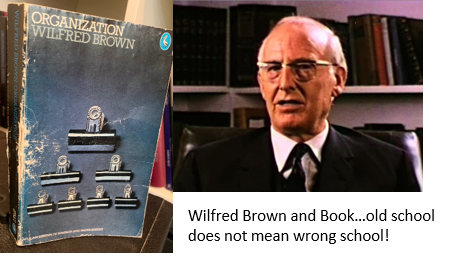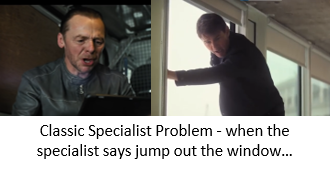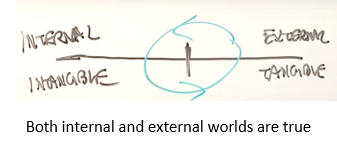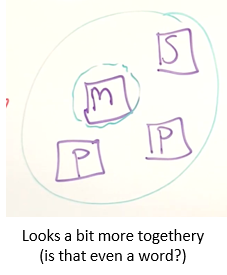The Specialist Problem – one of the biggest causes of cross-functional pain
Prefer to watch this on video than read? Just click here…5 mins with captions.
The Specialist Problem. You might not call it that…but you know about it. Let’s go through it.
The first mention of this problem I came across was in a book from 50 years ago by Wilfred Brown with the wonderful title of ‘Organization’. I love it because it couldn’t be less fashionable…check out the cover…

Don’t be fooled into thinking something from this era isn’t relevant – the genius of the Beatles finished in 1970, Led Zeppelin was getting going, and besides, Newtown copped the apple way back in the 1680s and his gravity idea still seems useful… so old does not mean irrelevant.
Specialists
What are we talking about here? I’m defining a Specialist as any role not directly involved in doing whatever the organisation is funded or can invoice for. Let’s call these Primary Activities, and the areas that do these ‘Production’. The rest are Specialists. Here’s how we might draw it in a traditional hierarchy:

Specialists generally serve three purposes, either doing this directly or setting up systems and methods to do so. And the same person might flick between the purposes as they do their job, Finance Business Partners are an example of a Specialist who will do all three. The three are…
- Improvement
- Coordinate work
- Ensure boundaries and regulations are met.
Why can’t managers do this stuff themselves? Two reasons – time and expertise. Managers and/or groups won’t always have enough of each of these and are going to turn toward Specialists to provide them. And as the world continually ratchets up its complexity – more and more expertise is going to be needed.
Creation and provision of reports, advice on matters from people to safety to technical, setting up and maintaining technology, and the new areas of innovation, agility coaches and the like. All of these are Specialists who don’t generate a dollar for the organisation…but are there to help those who do.
In theory.
Conflict
In reality this is a recipe for conflict. Production and Specialists can often have conflicting goals within the wider goal. Production is there to meet operational needs, so ultimately the organisation can keep getting paid. Specialists are going to need something to change in order meet what they are charged with – even activities that will improve production usually require stopping it for a while so we can make it better. And of course the classic conflicts of the Legal department forbidding something to go ahead as they are charged with ensuring laws are not broken conflicting with Production who sees such as laws as advice to be considered when achieving operational goals.

Conflict! The Specialist Problem! So what do we do?
The Goal Is Not Agreement
First – the goal. It is NOT to get agreement…yet. Surprised? Disagreement is a good thing – ideas come from the seeing of new angles, and 100% agreement means 0% new perspectives.
A better goal is to REDUCE TENSION and INCREASE TRUST. These two go together like a see-saw, and an environment of trust, which means I can disagree without worrying about what you’ll do afterwards that I might not know about…is going to lead to better solutions.
So our question now becomes how do we increase trust in the face of the Specialist Problem.
Within You and Without You
Another set-up point – we can adapt Ken Wilber’s integral model to see the world as having an Internal/Intangible aspect and an External/Tangible. The former are those things we know are real but we can’t see – feelings, relationships, culture, ‘the vibe’. A bit like the wind, we can only see the results of these things in others…but that doesn’t mean they’re not real. The latter are the things we can observe and look up, and one of the key things in this category is the organisational design, or more specifically for us…role relationships.
The internal and external work in an ongoing cycle, one influencing the other. This means that fans of Kumbaya as a way of resolving organisational conflict are missing half of the show. And those that believe in ‘fix the system fix the people’ as the silver bullet are also missing half. Neither approach is wrong…just not sufficient!

For our purposes of looking at these working relationships, see the external role relationship aspect as the scaffolding on which the two people are going to stand. Dodgy scaffolding causes people to respond in whatever way they naturally do to anxiety-producing situations…and a good relationship becomes that much harder. Solid scaffolding gives us a much better shot.

Visuals Matter
How do we make better sense of the external relationships? One thing we can do it draw it slightly differently. By going from the drawing from earlier to this…

We can still have the ‘layers’ that we saw in the traditional hierarchy, but there’s more of a ‘we’re working together’, organic sort of vibe. Never stop here though.
The Key To Role Relationships
No matter how we draw it, we must address how the role relationships work. Here’s the key. Remember that disagreement is inevitable, so
LET PEOPLE KNOW WHAT TO DO IF THEY CAN’T FIND AGREEMENT.
– me 🙂
Notice the word ‘find’. It’s reasonable to expect people to have a conversation about it to see if they can find a way through. Listen to each other’s interests, surface the underlying assumptions, and see if there’s a way to achieve it all. But…if there’s not…you must give them a way out of the Thunderdome.
And it is a Thunderdome. Have you noticed how intense things can get, when rarely are we talking sheep stations? It’s the deep fear of social system death that is perceived as possible if our goals aren’t met. That very human worry about whether we have any value at all. It just freaks us out (and if you happen to be one of those ‘go-getter’ types that often gets your way…that doesn’t mean you’re immune. Ask yourself why you need to win so much!)
The Options
Here are your options. Either way, your starting point is:
“If you’ve had a crack and you can’t get creative and find a solution that meets both of the goals we need from you, I don’t want compromises. We don’t change goals unilaterally. So when this happens….”
And here are your three options…
- “Production – you go ahead and do what you think is right. Your job is to listen and take on board. You don’t have to do it. Specialist – your job is to provide your best advice. If it’s not followed…that’s not on you.”
- “Come and see me. TOGETHER. I want to hear all the angles”
- “Production – do what the Specialist says, because their job is to ensure we don’t do things that could be terminal to the business”
Note that these three options, in order, decrease the authority of Production and increase the authority of the Specialist. The rule of thumb is to keep as much decision-making in the hands of those who generate the revenue or funding, so the second option is best only used for matters where adherence is necessary to keep the whole organisation integrated. And the last option is for matters of safety, brand reputation or running out of money.
The mention in the second option of going together is crucial. In a previous article on Positive Politics I referred to this as one of the key aspects of building trust – to make sure that people never find out afterwards that you took actions that negatively impacted them. Going together eliminates this occurring.
A quick side note – the same principles apply in a self-organising situation. The work of the Manager role still needs to occur, but now it might happen via an all-team meeting, or via referral to an agreed conflict resolution process. This includes both the setting up of the role relationships, as well as the resolving conflicts where solutions can’t be found. Self-organising doesn’t mean no organising.
Doing this does require a higher level of cognitive and emotional maturity to be able to effectively work through this, so moving to such a design might not be worth the pain if simply putting an effective manager in can do the job well.
Bringing it Home
The internal/intangible part of the equation deals with cognitive and emotional maturity as well the ability of people to show up as adults and engage in actual dialogue. That’s for a later article, for now, focus on setting up solid scaffolding by defining role relationships in terms of what to do if they can’t find agreement. That way they won’t be clinging to each other on a shaky foundation, which can bring even the best relationships crashing to the ground.

Solid foundations support solid relationships, which leads to getting the full value of what specialists have to offer…while still getting things done for those we’re here to serve.
Sounds like a reasonable idea.
